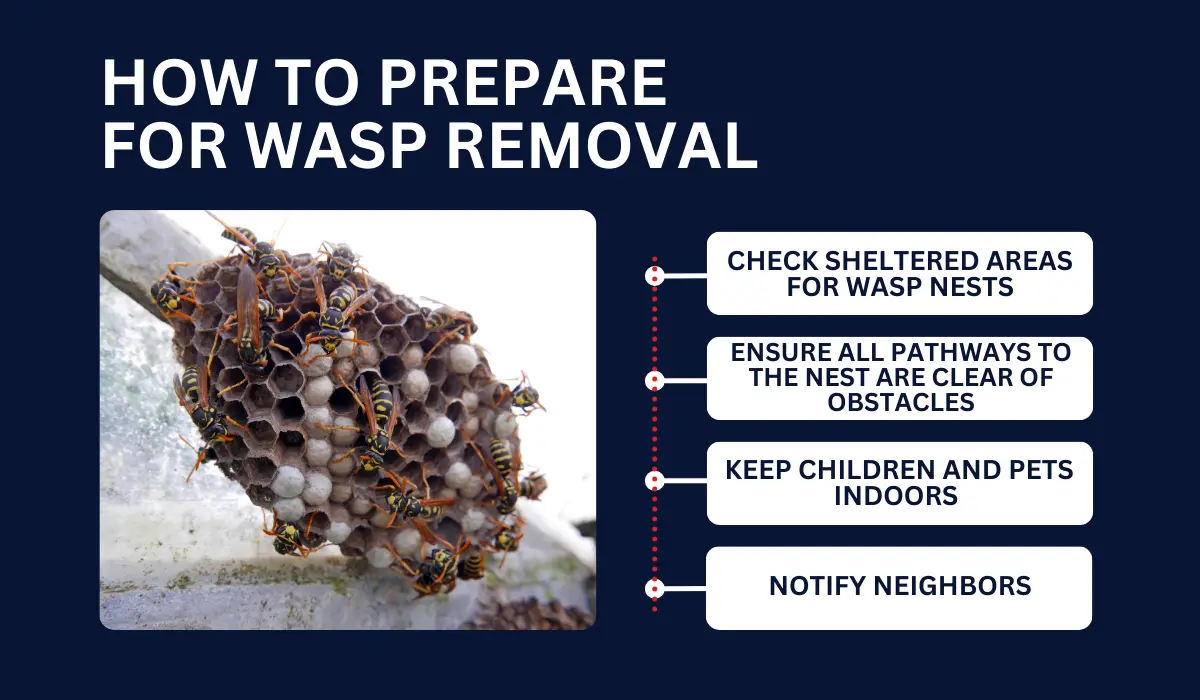Living in Louisiana has plenty of perks, but dealing with paper wasps isn’t one of them. Nothing can ruin a pleasant day in the yard like a sudden encounter with these aggressive insects.
Ready to reclaim your outdoor space? Stick around to learn why you need the professionals to get rid of paper wasps in Louisiana.
Key Takeaways
- DIY wasp removal is risky and often ineffective, making professional pest control services a safer and more reliable option.
- Professional removal involves detailed inspections, species identification, and eco-friendly eradication methods.
- Proper preparation for professional wasp removal may involve securing the area, ongoing monitoring, and maintenance to prevent re-infestation.
WHY WE RECOMMEND PROFESSIONAL WASP REMOVAL
Challenges of DIY Wasp Removal
Taking matters into your own hands with paper wasp nest removal can quickly become a nightmare. Many underestimate the danger of these social insects, missing crucial factors like aggressiveness.
When people try to do it themselves, they often use weak insecticides, wasp spray, or dish soap, which might not work ultimately. As a result, the risk of being stung becomes high, especially if an allergic reaction occurs.
Benefits of Calling a Pest Control Professional
Opting for professional pest control services ensures you are dealing with experienced experts. To ensure they don’t return, they bring specialized equipment and techniques that are more effective in removing wasp nests.
To minimize wasp stings, they can appropriately handle common types of wasps, such as yellow jackets and other stinging insects. They also offer preventative measures, maintaining a wasp-free environment in the long term.
WHAT TO EXPECT FROM PROFESSIONAL WASP REMOVAL
Professional wasp removal services in Louisiana involve thoroughly inspecting the problem and using safe techniques to remove wasps effectively.
Inspection and Assessment
Initially, a professional exterminator will conduct a detailed inspection of the property to locate and assess wasp activity. This helps in planning the appropriate removal strategy and tools required.
Here are critical aspects of this inspection and assessment process:
- Inspection Areas: Attics, tree branches, crevices.
- Nest Locations: Under eaves, in sheds, around windows.
- Activity Levels: How active or aggressive the wasps are.
- Potential Risks: Risks to people and pets during removal.
Identification of Wasp Species
The presence of other species, like mud daubers, cicada killers, and bald-faced hornets, can complicate identification. Here’s what they usually look for to confirm the identity:
| Physical Features of Paper Wasps | Description |
|---|---|
| Body Length | Typically, 1.9 to 2.5 cm (0.75 to 1 inch) long |
| Color | Usually brown with yellow markings |
| Body Shape | Slender body with a narrow waist |
| Wings | Long and narrow; fold longitudinally when at rest |
| Antennae | Typically long with 12-13 segments |
| Legs | Slender legs that dangle below when in flight |
| Stinger | Equipped with a stinger (only females sting) |
Safe Removal Techniques
Once the inspection is complete, professionals use safe and effective techniques to remove paper wasp nests. Here are typical removal techniques they use:
- Protective Gear: Full-body suits, gloves, face masks.
- Professional Chemicals: Eco-friendly sprays targeting paper wasps and hives.
- Physical Removal: Carefully dismantling nests from attics or tree branches.
- Relocation (If necessary): Moving honey bees and larvae if found.
HOW TO PREPARE FOR A PROFESSIONAL WASP REMOVAL

Preparing your home properly and understanding what to expect afterward is crucial to ensuring a smooth process for wasp removal, especially during late summer.
Prepare Your Home
Getting your home ready for professional wasp removal involves several essential steps, such as:
- Check sheltered areas where wasps can build nests.
- Ensure pathways to the paper-like nests are clear of obstacles.
- Keep pets and children indoors to avoid exposure to harmful chemicals.
- Notify neighbors, especially if they share a wall or eaves that may be affected.
Know the Post-Removal Considerations
Understanding what to expect after the removal will help you keep your home safe and wasp-free. To prevent another wasp infestation, consider these tasks:
| Aspects | Recommended Action |
|---|---|
| Regular Inspection | Check eaves, voids, and doorframes periodically for new nests. |
| Sealing of Access Points | Close gaps around windows, doorframes, and eaves where wasps can enter. |
| Cleaning Up High-Risk Areas | Remove any paper-like material, wood fibers, or debris left from nests. |
| Controlling Other Pests | Control other pests and insects like caterpillars that may become a food source. |
| Activity Monitoring | Monitor any wasp activity and call professionals early if needed. |
IS IT TIME TO CALL THE PROFESSIONALS?
Deciding when to hire pest management professionals can be tricky. If the number of paper wasps is overwhelming your DIY spray bottles and wasp traps, consider seeking pest control expert assistance.
Whether you’re in Baton Rouge or New Orleans, seeking expert help should be easy. For immediate intervention for a severe infestation, let Lajaunie’s wasp & hornet control specialists tailor a solution that’s right for your home.
For more information about the areas we service, visit our location page.
 By: LaJaunie's Pest Control
By: LaJaunie's Pest Control 


